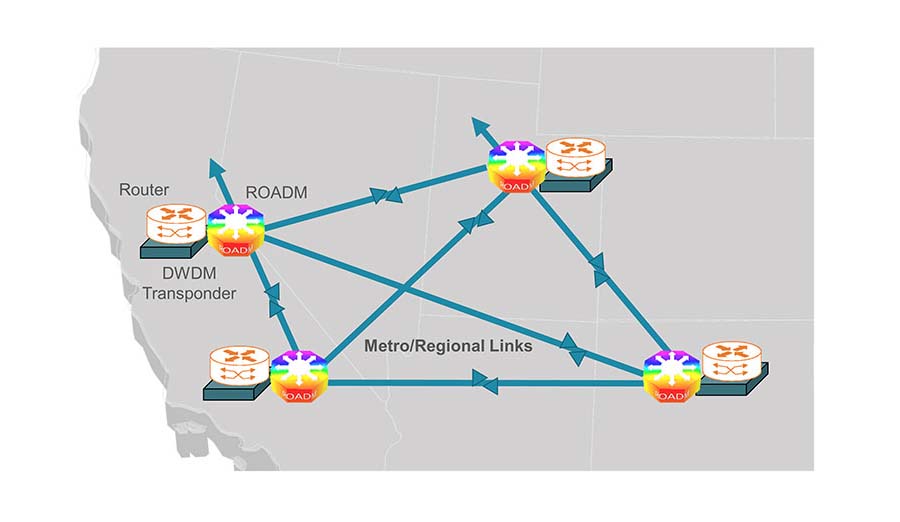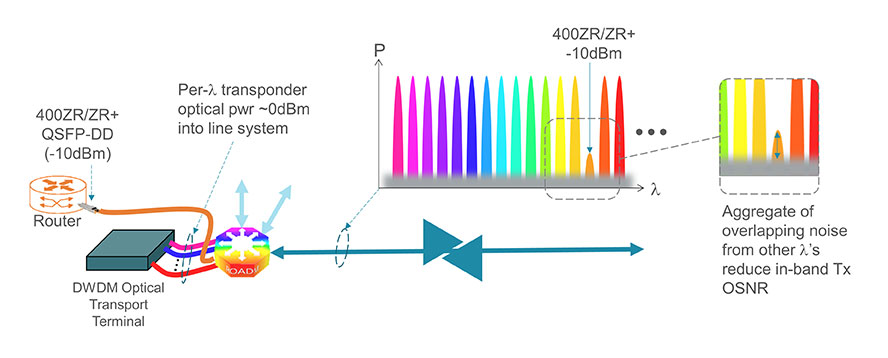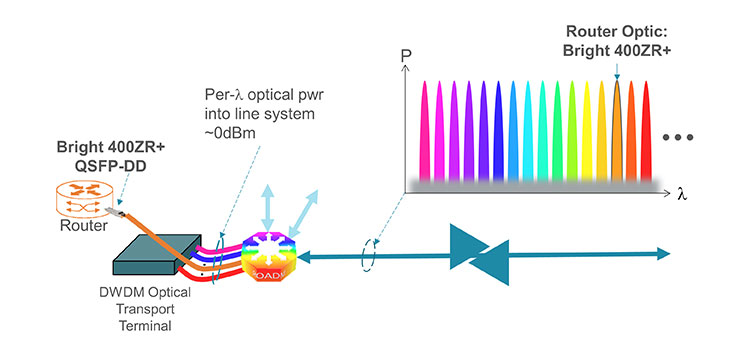A renaissance is occurring in the optical networking industry, enabled by the introduction of 400G coherent pluggable modules. The target applications for these solutions continue to expand. It began with the OIF 400ZR application router-to-router applications between hyperscaler data center sites with up to 120km reaches. These 400ZR modules, which plug directly into switch/router ports, provided network operators with an opportunity to forego a separate optical transport layer.
The 400G OpenZR+ MSA expanded 400ZR reaches far beyond 120km by utilizing higher-gain forward error-correction coding (FEC) and increased compensation for chromatic and polarization mode dispersion. This enabled the use of 400G pluggables not only in hyperscale environments, but also in metro/regional service provider network environments. Service providers have thus been focusing on these “plus” versions of 400G modules for their network needs.
Brightening ROADM Networks
The latest expansion of 400G pluggable applications is being enabled by QSFP-DD form-factor modules, such as Acacia’s Bright 400ZR+ QSFP-DD, which have an optical transmitter power at least ten times greater than 400ZR. The higher transmitter power expands the applications that can be addressed by 400G coherent pluggable modules to include brownfield and greenfield metro/regional networks with reconfigurable optical add-drop multiplexer (ROADM) nodes, shown in Figure 1.

Figure 1. Recently introduced Bright 400ZR+ QSFP-DD modules expand applications of 400G coherent pluggables to brownfield and greenfield metro/regional networks with ROADM nodes.
ROADMs enable the ability to selectively add/drop wavelengths to/from the network, avoiding optical-electrical-optical (OEO) conversions on channels passing through the ROADM node. Enabled by wavelength selective switch (WSS) technology, ROADM-based architectures can provide operational advantages compared to fixed optical add/drop solutions that required manual intervention for reconfiguration.
These network elements operate in tandem with terminal DWDM equipment and amplified single-span or multi-span line systems. To ensure optimal aggregate optical SNR performance, a certain level of transmit optical power and uniformity is required across the entire DWDM wavelength band. Having a 400G coherent pluggable QSFP-DD solution with high transmit optical power would enable 400G router-based optics to be deployed in a ROADM network architecture with existing wavelength traffic.
Bright Applications
Figure 2 illustrates two general examples of how Bright 400ZR+ QSFP-DD modules can be used in ROADM networks for sites with or without existing DWDM transponder terminal equipment.


Figure 2. 400G QSFP-DD pluggables with high transmit optical power can be used at a network node in new deployments (a) or with (b) existing DWDM transport/transponder terminal equipment.
IP-over-DWDM over ROADM Infrastructure
While point-to-point IP-over-DWDM architectures can be fully supported using 400ZR or OpenZR+ modules, there may be instances in which IP-over-DWDM traffic may need to traverse over a legacy ROADM infrastructure (Figure 2a), perhaps as an overlay with existing sites populated with DWDM transport terminal equipment (Figure 2b). Figure 2b also illustrates an alien-wavelength example where a router-port wavelength is inserted into a line system of a different vendor.
While there are network designs that support the use of -10dBm 400ZR+ modules over a ROADM network, it becomes a challenge when the DWDM transmission from these modules are adjacent to multiple legacy higher optical power channels (Figure 3a) resulting in relatively lower received optical power and OSNR. Legacy transponder terminal equipment typically have a per-channel ingress optical power in the 0dBm range. One solution is to add an external optical amplifier per module to boost the optical transmit power to the 0dBm level into the line system ingress.
By taking advantage of highly integrated silicon photonics design and packaging technology, such as Acacia’s 3D Siliconization, it is possible to eliminate the need for an external amplifier by incorporating the optical amplification into the compact QSFP-DD form factor module. Utilizing a 400G coherent pluggable with a higher optical transmitter power of at least 0dBm ensures sufficient optical power, relative to other DWDM wavelengths, to traverse through legacy ROADM nodes, as shown in Figure 3b.


Figure 3. (a) A standard 400ZR/ZR+ module with transmitter output power of -10dBm co-exists with legacy higher power channels, subject to lower received optical power and OSNR; (b) a Bright 400ZR+ wavelength ensures channel power uniformity in ROADM/line-system ingress when combined with other line-system traffic.
Transmitting in High Fidelity
Many ROADM architectures utilize colorless multiplexing. This type of ROADM has a passive optical combiner element (Colorless MUX in Figure 4) that takes individual fiber inputs from different transmission wavelengths and combines them together into a single fiber without any optical filtering, hence the name colorless. In wavelength-agile network designs, external control of the tunable wavelengths avoids any contention issues. To minimize wavelength crosstalk/noise through colorless ROADMs, the transmitter OSNR of each ingress wavelength needs to be maximized. One way to achieve this is to attenuate the laser amplified spontaneous emission (ASE) noise using a band-pass optical filter to minimize optical crosstalk/noise into nearby channels. And to accommodate wavelength-agile networks, a tunable optical filter (TOF) is utilized.

Figure 4. Illustration highlighting the benefits of a TOF inside a coherent module with internal optical amplification when multiple channels pass through a colorless multiplexer; comparison between (a) modules without TOF vs. (b) modules with TOF.
Figure 4 illustrates how multiple wavelengths are combined using a colorless MUX. In figure 4a, the noise from multiple modules without a TOF impacts nearby transmission channels through a colorless MUX. By using a TOF, not only does is transmit OSNR improved, but also the noise affecting adjacent channels is minimized. The Figure 4 inset illustrates how a TOF suppresses noise resulting in an optimal situation of a module wavelength insertion surrounded by legacy wavelength transmissions, shown in Figure 4b.
Higher Density DWDM Footprint
For network operators continuing to leverage an optical transport layer, the higher optical power QSFP-DD modules enable a higher density design for DWDM transponder terminal equipment. While high transmit optical power has been available in the CFP2 form factor for 400G, advanced integration and design has resulted in this capability in the smaller QSFP-DD housing.
The Acacia Bright Solution
Acacia recently introduced its Bright 400ZR+ coherent pluggable QSFP-DD module that transmits at least +1dBm of optical power to expand 400G coherent pluggable applications with brownfield and greenfield ROADM network architectures. This module leverages 3D siliconization to provide a highly integrated design enabling the silicon photonics integrated circuit (including TOF), coherent DSP, high-speed components, and optical amplifier to fit entirely into a compact QSFP-DD pluggable form-factor module. In addition to supporting interoperable OpenZR+ and Open ROADM modes, the Bright 400ZR+ QSFP-DD module can aggregate 4x100GbE client traffic and also utilize FlexO mapping for OTN transport applications.
Bright 400ZR+ Expands Applications for 400G Pluggables
High transmit power 400G pluggables, such as Acacia’s Bright 400ZR+ module, surpass the market applications served by 400ZR module by enabling an optical transmit power that is at least ten times greater (i.e., brighter). This is another significant milestone because it enables service providers and hyperscalers to take advantage of 400G pluggables in brownfield and greenfield ROADM based optical network architectures.
Additional Resources:
- Bright 400ZR+ coherent pluggable QSFP-DD module Product Page
- Arelion completes first multi-vendor, multi-layer field trial using Acacia Bright 400ZR+ modules and Cisco Routers


